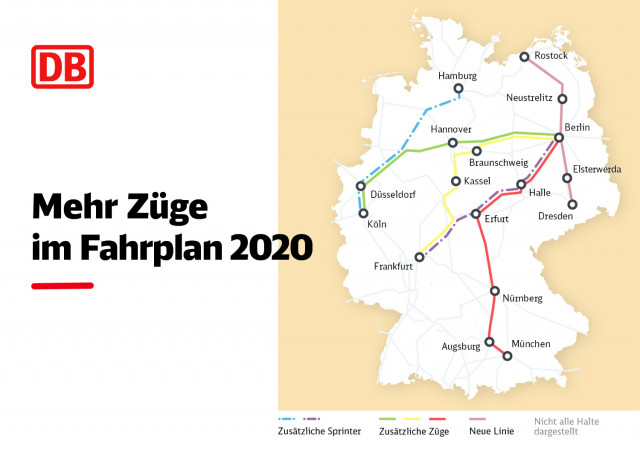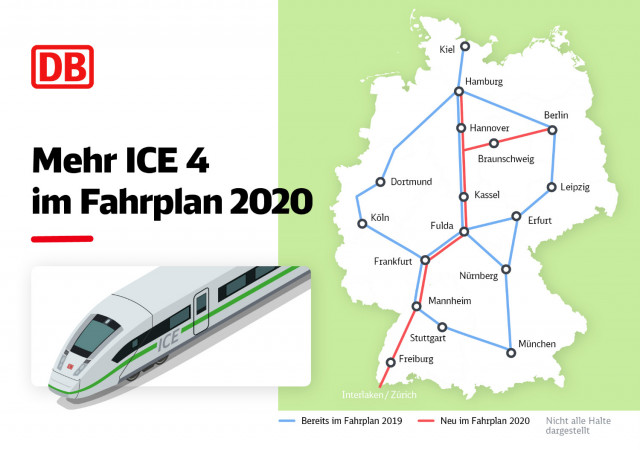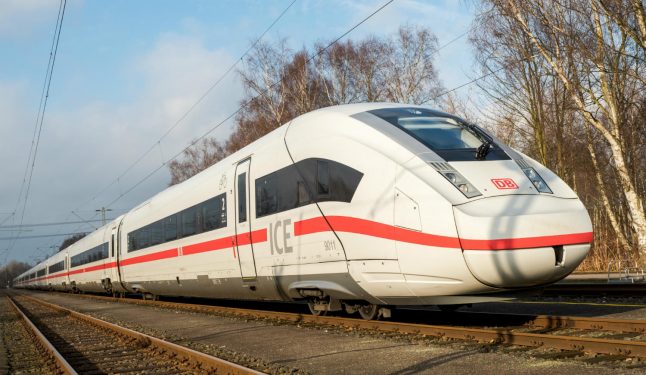With a new route planned and more trains on the tracks, Deutsche Bahn (DB) is trying to make travelling by rail more attractive in Germany.
And for the first time in years, the rail operator has refrained from increasing its rail prices, as is usually the norm with timetable changes – in fact tickets will likely become cheaper in future.
It's down to government plans to reduce the tax on rail tickets as part of the climate package, although the details are still being negotiated.
As part of the new timetable for 2020, services in the east get a boost with the launch of the new Dresden-Berlin-Rostock route.
DB said it wanted to become more punctual and expand capacities for rail travellers in Germany.
From the start of the year up until the end of September, 76.5 per cent of all long-distance trains arrived on time, according to the operator.
READ ALSO: How Germany plans to improve safety at railway stations
This was an improvement of 1.6 percentage points compared to the previous year – although almost every fourth long-distance train still arrived late.
“The 2020 timetable is a further milestone in strengthening the railways and the next step in the direction of Germany's regular service,” said DB Board Member Berthold Huber.
“On December 15th we will open a new long-distance line for our customers, consolidate the services offered on the German long-distance network on important routes and integrate new, attractive destinations in our neighbouring countries.”
What's new?
Most routes remain unchanged.
But from mid-December and throughout 2020 there will likely be more of DB's new ICE4 trains on the tracks.
The below map shows the new route (in pale pink), where additional trains will be used (in green, yellow and red) and where extra ICE Sprinters will be used (blue and purple).

DB says it is focusing on a stronger connections and on traffic growth between Germany's metropolitan regions. More trains will be used on important ICE lines. Here's an overview:
- There will be additional journeys on the ICE lines Berlin-Erfurt-Munich and Berlin-Braunschweig-Frankfurt/Main which will aim to provide an hourly service.
- On particularly high-demand connections such as Hamburg-Rhine/Ruhr, further high speed Sprinters and booster trains will supplement the existing hourly cycle. This increases the service between Hamburg and North Rhine-Westphalia by 15 percent.
- Services between Berlin and Munich and between Hamburg and Cologne will both grow by around 10 percent.
- DB will operate a 30-minute service between Hamburg and Berlin for the first time from the end of 2021.
New trains
Customers will be able to use the swish new ICE 4 models more frequently along the Upper Rhine and to Switzerland. The new trains will initially run on the Hamburg-Frankfurt-Karlsruhe-Basel-Zurich-Chur route. These models have more seats as well as bicycle compartments.
So far, the ICE 4 has been used between Berlin and Munich, Hamburg and Stuttgart as well as Hamburg and Munich. From June next year, the new ICE will also run between Berlin and Interlaken. In total, DB has ordered 137 of these trains.
READ ALSO: How travelling by train in Germany is set to improve
“Currently a brand-new ICE-4 is put on the rails every three weeks,” DB said.
The below map shows where the ICE 4 trains are already being used (in blue) and the routes trains will be introduced next year (in red).

Boost in eastern Germany
The new Dresden-Berlin-Rostock long-distance line will be launched when the timetable changes.
The new route will operate 10 times per day to begin with. From March, this connection is to be offered every two hours, amounting to 16 trips per day.
It will provide a boost to services between cities and regions in Saxony, Brandenburg, Berlin and Mecklenburg-Western Pomerania.
Six cities will receive a regular two-hourly long-distance connection again: Elsterwerda, Oranienburg, Neustrelitz and Waren (Müritz). Warnemünde and Schönefeld Airport will be added in May 2020. As soon as the new BER Airport opens in October next year, there will also be a stop there.
More comfort
DB hopes by upgrading trains and offering more services it can improve on its punctuality rate.
DB also wants to get rid of older models of trains and replace them with modern vehicles. Passengers can then benefit from free WLAN, the ICE portal, rest and family areas.
New connections abroad and overnight
The new timetable also brings with it extra European connections.
Together with the Czech rail operator CD and the Austrian operator ÖBB, DB will be offering a new high speed connection between Berlin-Dresden-Prague-Vienna-Graz from May.
READ ALSO: S-Bahn, trains and buses: Germany to inject an extra €1.2 billion in public transport
Services to Poland will also be improved: from summer 2020, the travel time on Eurocity trains between Berlin and Warsaw will be reduced by 30 minutes.
DB will also continue to expand its night services. In cooperation with ÖBB, there is a new Intercity night service on the Zurich-Berlin and Zurich-Hamburg routes. The night ICs will operate on these routes in conjunction with ÖBB's classic night trains.
Bookings for the new timetable have already started and the new timetable kicks in on Sunday, December 15th.



 Please whitelist us to continue reading.
Please whitelist us to continue reading.
Member comments